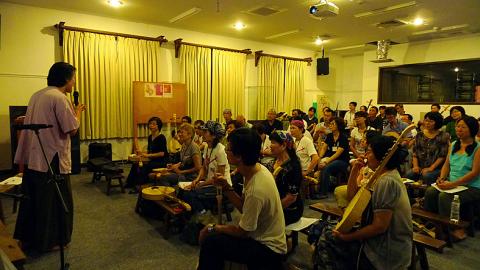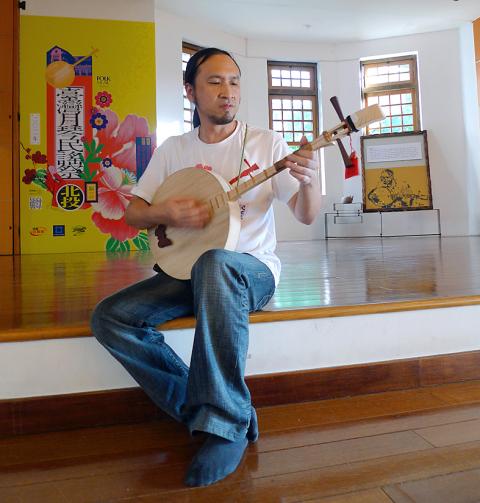Beitou District (北投), famed for its hot springs, is doubling as host to a musical feast this weekend. The Taiwan Moon Lute Folk Music Festival (台灣月琴民謠祭) comprises concerts tomorrow and Sunday at the Beitou Hot Springs Museum by a slew of the country’s top folk musicians.
The new festival began earlier this month with a series of lectures by folk virtuosos, who demonstrated the two-string instrument’s widespread use in Taiwanese music.
Iconic musician Chen Ming-chang (陳明章), who organized the event, said the moon lute, or yueqin (月琴), is a representative instrument of Hoklo music and commonly used in a variety of genres: Gezai opera (歌仔戲); Hengchun folk music (恆春調); nanguan (南管); beiguan (北管); chia-ko (車鼓); and liam kua (唸歌), a Taiwanese performance art form that interweaves talking and singing.

Photo courtesy of Taiwan Moon Lute Folk Music Association
“The yueqin is to Taiwan as the samisen is to Japan, or morin khuur to Mongolia,” Chen said, referring to stringed instruments from those countries. “It represents our culture’s most classical characteristics. I hope one day people will come to Taiwan to see yueqin or liam kua shows, just like we go to see samisen or kabuki shows when visiting Japan.”
Tomorrow evening there will be an open jam session with renowned musicians, including Chen and Lin Sheng-xiang (林生祥), that is open to anybody who wants to show off his or her yueqin skills.
Chen said the instrument generates a distinctive sound that is somewhat similar to that of blues music. Because of its simplicity, the yueqin’s timbre is more fluid and flexible than that of more elaborately designed Chinese instruments.

Photo courtesy of Taiwan Moon Lute Folk Music Association
“After Zheng Chenggong (鄭成功, better known as Koxinga) and his gang came to Taiwan, it was unlikely that they would go back to China just to buy a musical instrument. They were poor and could only use what was available at hand. They put together some wood planks, and now you have this simple tool that can produce amazingly complex music,” said Chen, who has taught yueqin to some 200 students in Beitou over the past two years.
On Sunday, octogenarian folk legends including Chu Ting-chun (朱丁順), under whom Chen has studied yueqin and Hengchun folk tunes, as well as Yang Hsiu-ching (楊秀卿) and Wang Yu-chuan (王玉川), both of whom are highly revered liam kua virtuosos, will perform.
Hailing from Yunlin County, the Wu Tien-lo (吳天羅) family’s Hsuyang Chia-ko Troupe (旭陽車鼓劇團) will show Taipei audiences the art of chia-ko, a type of grassroots operatic theater that combines song, dance, spoken dialogue and drama.
All of the festival performances will take place on the lawn outside the museum’s main building.
Aside from the musical performances, an exhibition of hand-painted moon lutes will run through Oct. 2 inside the museum, which was built in 1913 during the Japanese colonial era and designated as a heritage site in 1997. It is located a short, pleasant walk from Xinbeitou MRT Station (新北投捷運站).

In the March 9 edition of the Taipei Times a piece by Ninon Godefroy ran with the headine “The quiet, gentle rhythm of Taiwan.” It started with the line “Taiwan is a small, humble place. There is no Eiffel Tower, no pyramids — no singular attraction that draws the world’s attention.” I laughed out loud at that. This was out of no disrespect for the author or the piece, which made some interesting analogies and good points about how both Din Tai Fung’s and Taiwan Semiconductor Manufacturing Co’s (TSMC, 台積電) meticulous attention to detail and quality are not quite up to

April 21 to April 27 Hsieh Er’s (謝娥) political fortunes were rising fast after she got out of jail and joined the Chinese Nationalist Party (KMT) in December 1945. Not only did she hold key positions in various committees, she was elected the only woman on the Taipei City Council and headed to Nanjing in 1946 as the sole Taiwanese female representative to the National Constituent Assembly. With the support of first lady Soong May-ling (宋美齡), she started the Taipei Women’s Association and Taiwan Provincial Women’s Association, where she

It is one of the more remarkable facts of Taiwan history that it was never occupied or claimed by any of the numerous kingdoms of southern China — Han or otherwise — that lay just across the water from it. None of their brilliant ministers ever discovered that Taiwan was a “core interest” of the state whose annexation was “inevitable.” As Paul Kua notes in an excellent monograph laying out how the Portuguese gave Taiwan the name “Formosa,” the first Europeans to express an interest in occupying Taiwan were the Spanish. Tonio Andrade in his seminal work, How Taiwan Became Chinese,

Mongolian influencer Anudari Daarya looks effortlessly glamorous and carefree in her social media posts — but the classically trained pianist’s road to acceptance as a transgender artist has been anything but easy. She is one of a growing number of Mongolian LGBTQ youth challenging stereotypes and fighting for acceptance through media representation in the socially conservative country. LGBTQ Mongolians often hide their identities from their employers and colleagues for fear of discrimination, with a survey by the non-profit LGBT Centre Mongolia showing that only 20 percent of people felt comfortable coming out at work. Daarya, 25, said she has faced discrimination since she